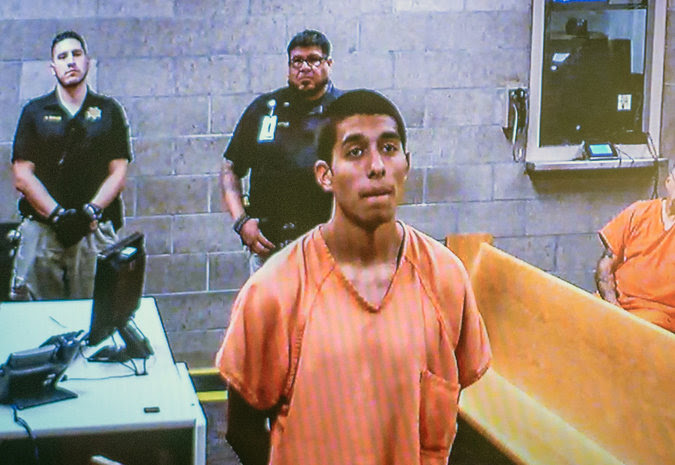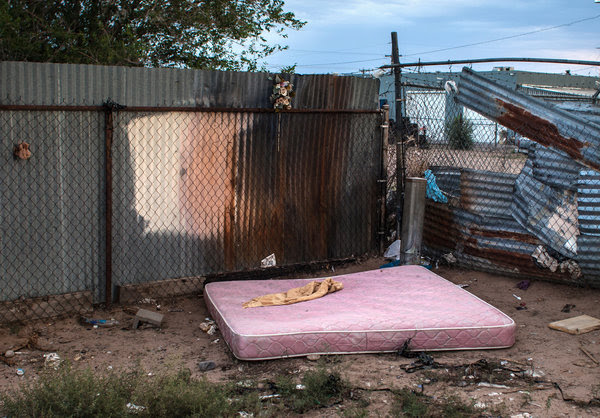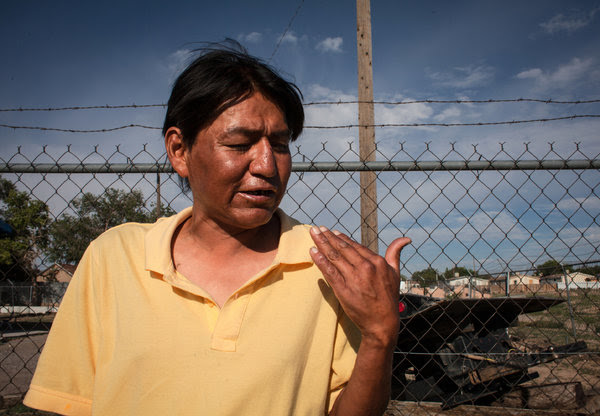NOTES BY NORSE: A tip of the hat to Colin Campbell Clyde for passing on this story. Yesterday at the Food Not Bombs meal, a man claimed he and a female friend had been accosted by five youths (all white and male) as they came back from the Boardwalk and headed for San Lorenzo Park. The men had baseball bets and threatened the two with beatings if one of them didn’t give up his bike. He claims he refused and was able to leave without further injury. This guy is not always credible.
However another woman reported on my Sunday Free Radio show that several nights before she saw several policeman using what she considered excessive force on a man who appeared homeless to her at Ocean and Water St. near a bus stop there. She was driving in her car, she reported, and heard the victim screaming help. She stopped the car, got out and watched, and was concerned that a third police officer a woman–had her knee on the back of the prone man behind held down.
I am concerned to hear (and particularly to see, if anyone has video or other documentation) accounts of threats, assaults, and similar intimidations that are happening. Please call me at 831-423-4833, e-mail me at rnorse3@hotmail.com, or post an account at www.indybay.org/santacruz .

Alex Rios, 18, is one of three suspects being held on $5 million bond in the killing of two homeless people. He was arraigned by video from jail. Credit Roberto E. Rosales/Albuquerque Journal, via Associated Press
ALBUQUERQUE — Jerome Eskeets’s last sight before he fell asleep on a soiled mattress late on Friday, on an empty lot speckled by shards of liquor bottles and discarded syringes, was the stars that glistened up above — “a beautiful thing,” he recalled this week, drunk, already, at 9:30 a.m. A cousin lay next to him that night, their bodies warmed by the cheap vodka they had shared. It had been “a good night,” Mr. Eskeets said, until he felt a dull pain on the bridge of his nose, a punch by one of the masked assailants that surrounded them.
“Cowards,” Mr. Eskeets exclaimed on Tuesday as he stood by the scene of the crime.
The assailants kicked and beat them, Mr. Eskeets said, using their hands and whatever else they could find — a metal pipe, wooden sticks, cinder blocks. Mr. Eskeets eventually broke free and ran away. His cousin, whose name he said was Al Gorman, and another homeless man he knew only as Cowboy, ended up dead. The police said they had both been disfigured beyond recognition by the thrashing, which included having their heads smashed repeatedly with the cinder blocks.
Photo

Two men were beaten to death in a litter-strewn lot in Albuquerque, attacks the police said were staggering in their brutality. Credit Mark Holm for The New York Times
Someone directed the officers to a stucco house on the other end of the lot, where a 15-year-old boy came to the door wearing shorts splattered in blood. Later, the boy told detectives that he, his 16-year-old half brother and their friend Alex Rios, 18, had taken turns assaulting the men. According to a criminal complaint, the teenagers had been “randomly attacking homeless people for over a year” and, by the 15-year-old’s estimates, they had beat up more than 50 since moving to the stucco house some months ago, as if it were a distraction, or a sport. As far as anyone could tell, though, this was the first time the beatings had resulted in deaths.
The killings exposed some of the profound social ills — alcoholism, abject poverty, neglect — that have long plagued New Mexico, a place best known for its stunning landscape. Since 1997, the state has led the nation in the number of alcohol-related deaths, according to the Centers for Disease Control and Prevention. There is a large homeless population and, in a strange twist, a man named Victor Prieto, who identified himself as the father of the two boys, told KOB-TV in Albuquerque that he and the boys had been homeless at one point. (No one came to the door on Tuesday or Wednesday at the apartment where the family lives.)
Still, for all the dangers of living on the streets, the police said that such a vicious attack by teenagers was staggering and callous in its brutality — the only motive the teenagers supplied for the attack was that one of the boys was angry because he had just broken up with a girlfriend. According to the complaint, the 16-year-old threw dirt on the victims’ faces and said, “Eat mud.” When speaking to the police, the teenagers could not agree on how long the episode lasted: One said it went on for an hour, another said 20 minutes. After it was over, they went home and fell asleep, according to the complaint. The 16-year-old told the police that “he looked at himself in the mirror and saw the devil.”
Officer Simon Drobik of the Albuquerque Police Department said detectives had been combing through reports of assaults on homeless people to see if any may be linked to the three suspects accused of the weekend’s killings. He said that the younger boys had “minor stains” on their juvenile records, mostly for truancy and marijuana possession, and that Mr. Rios “had never been in too much trouble.”
“They just seemed to be lost kids,” Officer Drobik said.
The two juveniles had both dropped out of school — the 16-year-old after finishing eighth grade, and the 15-year-old after a middle-school suspension in February 2013, a spokesman for the city’s public school system said. Mr. Rios, for his part, was not enrolled in the school system, and it is unclear if he had been going to any school at all.
The half brothers lived with their father in one of the apartments at the stucco house, in a slice of Albuquerque’s west side known for its limited choices: Some struggle to get by, keeping their heads low and their mouths shut to avoid trouble, and some are lost to dysfunction and addiction. Chayo Perez, pastor at the Door Christian Fellowship, a Pentecostal church across the street from the lot, described his congregation as “a herd of exes — ex-drunks, ex-addicts, ex-cons.”
In court on Monday, the two juveniles confronted the accusations they face: Certified as serious youthful offenders, they could be tried as adults if a grand jury indicts them on first-degree murder charges, which carry a mandatory life sentence. Judge Linda Rogers of Bernalillo County Metropolitan Court set bond for them and Mr. Rios, who was arraigned by video from jail, at $5 million.
Photo

Jerome Eskeets was able to break free and run from the attack that killed his cousin and a man he knew only as Cowboy. Credit Mark Holm for The New York Times
In an interview, Mayor Richard J. Berry described the killings as “the saddest, most tragic thing I’ve seen” and said they “bring to light the plight of the homeless and just how dangerous it is out there on the streets.” The crime also highlights the confounding challenges facing the city, he said, like the lack of a centralized system listing the number of beds available in emergency shelters on any given night.
A survey by Heading Home, a nonprofit organization that has housed 328 chronically homeless people in Albuquerque since 2011, found that three in five of the 1,300 respondents had been assaulted at some point while living on the streets. Most, however, never notified the police, said the group’s director of development, Megan McCormick.
“There’s a fear of retaliation, a sense that the police sometimes can re-victimize them,” Ms. McCormick said.
Albuquerque has been struggling to overhaul its police department, castigated this year by the Justice Department for its excessive use of force. Particularly divisive was the police’s fatal shooting this year of James Boyd, a mentally ill homeless man. On Tuesday, officers fatally shot a man wanted on parole violations during a foot chase, making him the 27th person killed by the police since January 2010. One of those shootings, on Aug. 30, 2011, happened on the same lot where the homeless men were beaten to death over the weekend.
Mr. Eskeets — who said he was Navajo, like the men killed over the weekend — said that the teenagers had set upon him once before, last week or maybe the prior week, but that he had threatened them with an empty beer bottle and they had fled.
“I never told no one because no one cares,” he said flatly.
Since the attack, Mr. Eskeets has struggled to make sense of what happened. “Those boys knew me,” he said, his eyes filling with tears. “They called me Skeets.”
Officer Drobik said there was no evidence that the teenagers had targeted the homeless men because they were American Indian.
Pastor Perez said he held Christian music concerts and cookouts in the church’s parking lot on Saturday mornings, attracting addicts, prostitutes and homeless people, and also neighborhood youths. He recalled seeing the teenagers there sometimes.
Jesus Garza, one of the volunteers at the Church of Christ, not far from the lot, said he used to see them often, roaming the streets. “They didn’t carry themselves as if they were thugs or gangsters,” Mr. Garza said. “I always thought of them as average kids.”